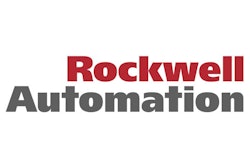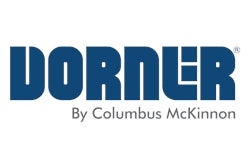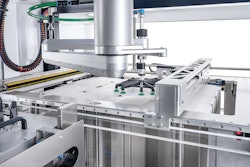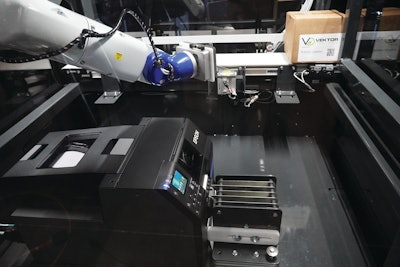
Integrator and OEM PharmaMed Automation was asked to build case labeling equipment for a manufacturer of liquid level sensors and alarm systems. The client requested a fast, full-color, on-demand label printer and a fast, flexible, and precise means of affixing the labels. Answering the call, PharmaMed designed and built a self-contained labeling cell with a color inkjet label printer, a 6-axis robot, a custom label track, custom tool head, and a conveyor, with all logic residing in the robot’s built-in controller. This experience, with a specific request to investigate Epson robotics and printers, snapped PharmaMed out of what it the integrator now considers to be an antiquated devotion to single machines accomplishing singular tasks.
“We liked to call it hard automation because it’s hard to do,” jokes Justin Mattson, Sales Engineer for PharmaMed Automation. He’s riffing on that traditional process where factory integrators allocate machines and equipment to single, fixed tasks. “Hard automation is all about rigidity, about building something that does one thing, and it’s harder because there’s no flexibility.”
Dustin Hanson, PharmaMed president, agrees. “It’s frustrating because there are so many applications where a SCARA or 6-axis robot would be the way to go, but the budget doesn’t allow it.’”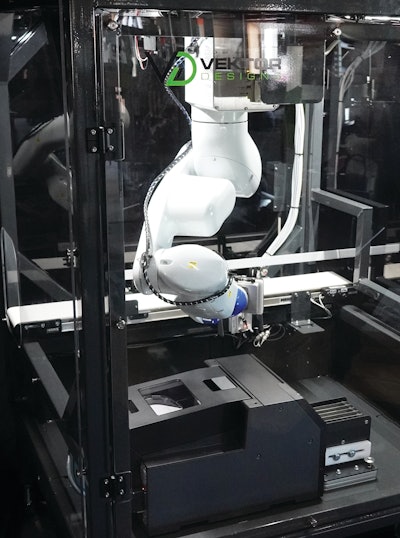 Epson VT6L All-in-One 6-Axis Robot and Epson ColorWorks CW-C6000P Color Inkjet Label Printer work together to enable precise label placement on an assortment of corrugated cases.
Epson VT6L All-in-One 6-Axis Robot and Epson ColorWorks CW-C6000P Color Inkjet Label Printer work together to enable precise label placement on an assortment of corrugated cases.
Mattson’s and Hanson’s experience with Epson Robots and Epson Colorworks began just over a year ago, in 2022, when a liquid level sensor and alarm manufacturer client distinctively asked them to look at Epson’s ColorWorks CW-C6000P Color Inkjet Label Printer in combination with an Epson VT6L All-in-One 6-Axis Robot to print and apply labels. Since that introduction, the integrator has used 10 more Epson robots in projects for other clients.
“With Epson all-in-one platforms, our whole operation has opened up,” Mattson says.
Paradigm shifting project
Hanson describes PharmaMed Automation, based in Fargo, North Dakota, as a small and nimble engineering company that specializes in the most challenging factory automation projects.
He says that, when he founded PharmaMed with partner Walt Stewart in 2012, “the focus of the company was the manufacturing of custom, generally non-robotic, hard automation cells for pharmaceutical and medical device companies.”
Yet Hanson was intimately familiar with robotics and had worked with almost every brand of industrial robot at one time or another during his career. “Actually, at the company I was at before we started PharmaMed, we developed our own SCARA robot and the software to control it. It was the first SCARA robot developed on the Rockwell platform.”
He explains that “the job we do is very difficult, because we’re always trying to solve some new problem that no one else wants to touch. It’s a high risk, high reward type of business.”
In 2018, he and Mattson founded another company, Vektor Designs, to serve a more general manufacturing base. They merged the two firms in 2022.
Working under the Vektor brand, Hanson and Mattson took on this new client, the manufacturer of liquid level sensors and alarm systems. The client packages these sensors in corrugated cases of about 8 x 8 in. in length and width, and either 6 in. or 8 in. in height. It then labels these cases with a self-adhesive label that’s 6 in. wide and 4 in. tall.
Even though the switches are sold through commercial plumbing contractors, the client had been wanting to go to a full-color label to set itself apart from competitors. The company also wanted to create a more consistent look than is possible with hand-applied labels. 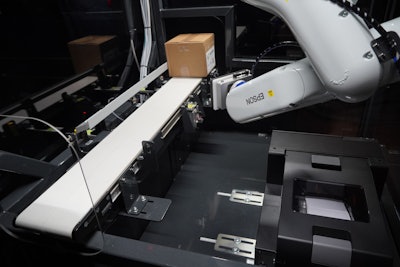 Custom self-contained labeling cell with an Epson VT6L All-in-One 6-Axis Robot and Epson ColorWorks CW-C6000P Color Inkjet Label Printer and custom label track, toolhead, and conveyor.
Custom self-contained labeling cell with an Epson VT6L All-in-One 6-Axis Robot and Epson ColorWorks CW-C6000P Color Inkjet Label Printer and custom label track, toolhead, and conveyor.
Most importantly, the client was facing a huge staffing challenge, with a workforce that had dropped from about 700 prior to COVID-19 to just 400, so an automated workflow was highly desirable.
The client, Mattson says, had seen the Epson ColorWorks printer and wanted to use it in this application.
“You can buy pre-printed labels and put them onto an off-the-shelf labeling machine, but then every label on the reel is going to be the same,” he explains. “But this client might box up eight of their switches, then box up 10 more of another model, and so they need the flexibility to send any print run of any quantity to the system.”
Mattson also says the CW-C6000P is fast and reliable, able to print, trim, and peel labels 8 in. wide and any height at up to 5 in. per second. Completely digital, it can switch from one label design to another without pausing. Furthermore, it comes standard with an I/O port so it can easily be integrated onto an automated system.
“Beyond the label printing,” Mattson adds, “they saw that it was a better option for them to use a robotic arm to pick and place it than any sort of fixed machine.”
While hard automation is traditionally less expensive than robotics, the prices of the Epson robots were attractive to the client and the Vektor/PharmaWorks design team. “Once you can buy a high-quality SCARA for under $10,000, or a 6-Axis for under $15,000, that changes things,” Hanson says.
The team designed a self-contained cell with the ColorWorks printer, a custom-built track to carry the labels, and a ceiling-mounted VT6L robot to pick up each label then apply it to the case, which is carried into position by a Dorner conveyor. The team designed and built their own pneumatic toolhead, which not only applies the label but then backs off and taps it to make sure it’s firmly applied. Then the conveyor brings up the next case.
“We have a sensor embedded into the toolhead to verify that a label is present, and then we verify that it’s been applied to the case,” Mattson says.
For now, he says, the client always applies the label into the same position on the side of each case, but by using a robot rather than a fixed labeling solution, they know they’ll be able to vary the case size and placement with just a simple software change.
The client, Mattson says, originally ordered two of these self-contained labeling machines, but when they saw how well it worked, they soon ordered a third.
Change in attitude
Since starting on the project, PharmaMed has used Epson robots with three other clients, including two where they integrated Epson with the Siemens automation platform and one with Rockwell.
“We actually used the Epson controller to power the entire labeling cell, but it’s a small cell with a couple of air cylinders, the conveyor, and this printer. But really when you start using a robot with the major platforms, that’s where the rubber hits the road,” Hanson says. “For us that’s big, and it’s mainly because we’re putting Epson robots into projects where we would not have used any robot in the past. You get to a price point where quantities can go up and you can get volume. Volume, in turn, is how you can get your cost down. I know that’s Epson’s play, and it’s our play as well… the reason we fell in love with the product.”
There are good and bad points with every product and every business, “but we know our pain points,” Hanson says. A big source of pain is the difficultly of designing and building fixed automation solutions. “We try to get rid of pain, and so we’re willing to make a change if we find something that works well.
“An Epson robot,” he adds, “has the features and the price point we need. It’s a good, reliable product. Programming is straightforward using the Epson RC+ environment, and it integrates well with Siemens and Rockwell, which is important for us. And it has great support.”
Would they recommend Epson for other clients’ and automation integrators’ packaging projects?
“Yes,” Hanson says. “For sure.” PW



